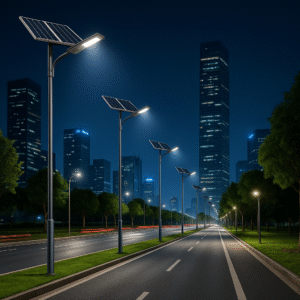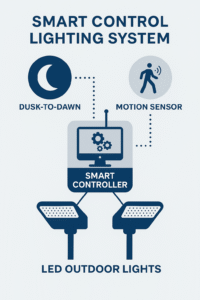Refined Energy Savings
Demand-based dimming by lamp and time window (e.g., 30–50% after midnight) or alternate-on strategies deliver measurable kWh reduction without sacrificing safety.
Definition
Single-lamp control is the capability to manage each streetlight individually—switching, dimming, and monitoring—rather than treating a whole circuit as one unit.
Traditional control
All luminaires on the same line switch on/off together at one brightness level, offering no per-fixture management.
Single-lamp (DALI) control
Using the DALI protocol, each luminaire is assigned a unique short address and becomes an independent node on the lighting network. The control center can send one-to-one commands to any specific lamp for precise on/off, percentage dimming, status reading, and diagnostics.
How it works—in one line
DALI bus ⇢ addressed LED driver in each pole ⇢ the driver adjusts output current to deliver the commanded brightness for that single fixture.
Assigning a unique address to each luminaire unlocks precise energy management, proactive maintenance, safer roads, and flexible operations across complex corridors.
Demand-based dimming by lamp and time window (e.g., 30–50% after midnight) or alternate-on strategies deliver measurable kWh reduction without sacrificing safety.
Per-lamp fault alerts, runtime and energy logs enable proactive dispatch and lower OPEX—no more manual night patrols for detection.
Instantly raise brightness on specific sections during incidents, fog or heavy rain. Sensor triggers light ahead of pedestrians/vehicles in energy-saving mode.
Apply independent brightness policies at intersections, bus stops, bridges or campuses—no rewiring or circuit-wide reconfiguration required.
With a unique DALI short address per luminaire, operators can switch, dim, group, monitor, and configure each streetlight independently—on demand or by schedule.
Per-lamp on/off and 0.1–100% stepless dimming.
Apply brightness setpoints by time window, corridor, or sensor triggers without affecting adjacent poles.
Create logical groups (e.g., main carriageway, sidewalk, intersection).
Call scenes like Midnight, Rain/Fog, Holiday—executed instantly or by schedule.
Read real-time status, brightness, power, energy, and runtime.
Receive fault codes such as open/short circuit, over-temperature, or communication errors.
Enables targeted maintenance dispatch and lowers OPEX.
Configure fade time, default power-on levels, dimming curves, and sensor linkages remotely.
Push updates to single lamps or selected groups.
| Action | Example | Outcome |
|---|---|---|
| Set brightness | Set Lamp #23 to 35% from 00:00–05:30 | Energy reduction without affecting adjacent lamps |
| Call scene | Trigger “Fog Mode” for the intersection group | Instant boost to 90% with smooth fade-in |
| Read telemetry | Pull power & energy for last 7 days | kWh analytics for billing & ROI reporting |
| Diagnostics | Receive over-temperature alert on Pole A-17 | Targeted maintenance dispatch; prevent outage |
| Parameter update | Change default power-on to 50% with 3s fade | Better neighbor comfort; fewer glare complaints |
Tip
Use scenes for corridor-wide effects, and single-lamp overrides for temporary tasks such as incident response or inspections.
The driver is the core component inside each streetlight.
Receives DALI digital commands (0–100% dimming level).
Adjusts output current accordingly to control lamp brightness.
Installed inside a cabinet or distribution box.
Acts as the “brain” of the local DALI line, issuing commands and collecting feedback.
One DALI line supports up to 64 individual addresses.
Connects the field gateway to the management platform.
Options include 4G/5G cellular, Ethernet, LoRaWAN, or NB-IoT.
Ensures long-distance, reliable, and secure data transmission.
Provides a map-based visual interface of all poles and lamps.
Operators can click each lamp to check status, change brightness, or apply scenes.
Stores telemetry, fault logs, and energy reports for analytics.
To achieve per-lamp addressability, a DALI-based single-lamp control system integrates specialized hardware and software layers. Each element plays a role in ensuring reliable communication, precise dimming, and real-time monitoring.
The driver is the core component inside each streetlight.
Receives DALI digital commands (0–100% dimming level).
Adjusts output current accordingly to control lamp brightness.
Installed inside a cabinet or distribution box.
Acts as the “brain” of the local DALI line, issuing commands and collecting feedback.
One DALI line supports up to 64 individual addresses.
Connects the field gateway to the management platform.
Options include 4G/5G cellular, Ethernet, LoRaWAN, or NB-IoT.
Ensures long-distance, reliable, and secure data transmission.
Provides a map-based visual interface of all poles and lamps.
Operators can click each lamp to check status, change brightness, or apply scenes.
Stores telemetry, fault logs, and energy reports for analytics.
Our catalog offers modular, energy-saving, and high-performance LED solutions. Share your project needs, and we’ll create a tailored lighting plan for you.



For more professional knowledge and practical guidance, visit our blog to discover in-depth articles on LED street lights and project solutions.
What Is Timer-Based Dimmi
Outdoor Lighting Installa
Introduction – Why Upgrad

Introduction As cities an

Introduction Outdoor ligh
How to Waterproof LED Lig